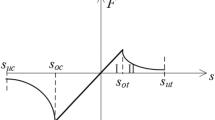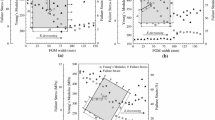Abstract
Functionally graded materials (FGMs) can be used as an interlayer. The interlayer connects two homogeneous materials and slows mutations in material properties, owing to the variability of parameters and microstructure. In this numerical simulation, a bond-based peridynamic (PD) model was used to perform dynamic fracture analysis of a continuous beam and a sandwiched structure with an FGM interlayer. Some simulation results of two convergence studies, which include grid refinement (m-convergence) and the reducing radius of PD horizon (\(\delta \)-convergence), were discussed. Under a four-point bending load, the propagation behaviors of single pre-crack in the continuous beam with the FGM interlayer at different locations are simulated to compare with the experimental results. For the sandwiched structure, the problems of a single crack and double cracks were considered. The numerical results show that the crack can deflect toward areas where the energy release rate is low. Additionally, the crack on the weak side for symmetric cracks only has fracture behavior, and if the double cracks are asymmetrical, all these cracks have fracture behaviors and propagation of the initial crack in the stiff region has a higher sensitivity than in the compliant region.









Similar content being viewed by others
References
Silling SA. Reformulation of elasticity theory for discontinuities and long-range forces. J Mech Phys Solids. 2000;48:175–209.
Silling SA, Epton M, Weckner O, et al. Peridynamic states and constitutive modeling. J Elast. 2007;88:151–84.
Bobaru F, Zhang G. Why do cracks branch? a peridynamic investigation of dynamic brittle fracture. Int J Fract. 2015;196:59–98.
Ren H, Zhuang X, Cai Y, et al. Dual-horizon peridynamics. Int J Numer Meth Eng. 2016;108:1451–76.
Ren H, Zhuang X, Rabczuk T. Dual-horizon peridynamics: a stable solution to varying horizons. Comput Meth Appl Mech Eng. 2017;318:762–82.
Fan H, Li S. A peridynamics-SPH modeling and simulation of blast fragmentation of soil under buried explosive loads. Comput Meth Appl Mech Eng. 2017;318:349–81.
Gu X, Zhang Q, Huang D, et al. Wave dispersion analysis and simulation method for concrete SHPB test in peridynamics. Eng Fract Mech. 2016;160:124–37.
Zhou X, Wang Y, Qian Q. Numerical simulation of crack curving and branching in brittle materials under dynamic loads using the extended non-ordinary state-based peridynamics. Eur J Mech. 2016;60:277–99.
Cheng Z, Zhang G, Wang Y, et al. A peridynamic model for dynamic fracture in functionally graded materials. Compos Struct. 2015;133:529–46.
Chen Z, Bobaru F. Peridynamic modeling of pitting corrosion damage. J Mech Phys Solids. 2015;78:352–81.
Chen H. Bond-associated deformation gradients for peridynamic correspondence model. Mech Res Commun. 2018;90:34–41.
Shojaei A, Mossaiby F, Zaccariotto M, et al. An adaptive multi-grid peridynamic method for dynamic fracture analysis. Int J Mech Sci. 2018;144:600–17.
Du Q, Tao Y, Tian X. A peridynamic model of fracture mechanics with bond-breaking. J Elast. 2017;132:1–22.
Cheng Z, Liu Y, Zhao J, et al. Numerical simulation of crack propagation and branching in functionally graded materials using peridynamic modeling. Eng Fract Mech. 2018;191:13–32.
Zhang Y, Cheng Z, Feng H. Dynamic fracture analysis of functional gradient material coating based on the peridynamic method. Coatings. 2019;9(1):62.
Ha YD, Bobaru F. Characteristics of dynamic brittle fracture captured with peridynamics. Eng Fract Mech. 2011;78:1156–68.
Bobaru F, Yang M, Alves LF, et al. Convergence, adaptive refinement, and scaling in 1D peridynamics. Int J Numer Meth Eng. 2010;77:852–77.
Delale F, Erdogan F. The crack problem for a nonhomogeneous plane. ASME J App Mech. 1983;50:609–14.
Kim JH, Paulino GH. Simulation of crack propagation in functionally graded materials under mixed-mode and non-proportional loading. Int J Mech Mater Des. 2004;1:63–94.
Rousseau CE, Tippur HV. Compositionally graded materials with cracks normal to the elastic gradient. Acta Mater. 2000;48:4021–33.
Acknowledgements
This work was supported by the Natural Science Foundation of China (Nos. 11872339, 11472248) and the Natural Science Foundation of Henan Province (No. 182300410221).
Author information
Authors and Affiliations
Corresponding author
Rights and permissions
About this article
Cite this article
Cheng, Z., Fu, Z., Zhang, Y. et al. A Peridynamic Model for Analyzing Fracture Behavior of Functionally Graded Materials Used as an Interlayer. Acta Mech. Solida Sin. 33, 781–792 (2020). https://doi.org/10.1007/s10338-020-00173-0
Received:
Revised:
Accepted:
Published:
Issue Date:
DOI: https://doi.org/10.1007/s10338-020-00173-0




